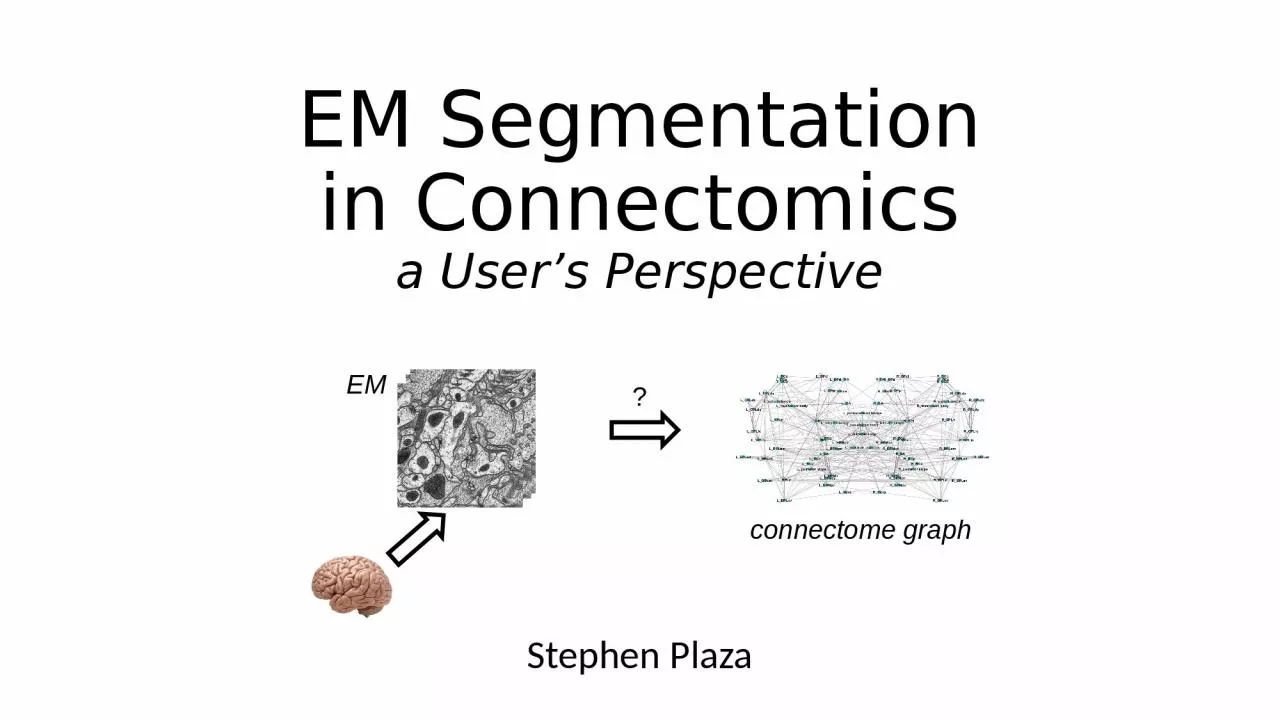

a Users Perspective Stephen Plaza EM c onnectome graph Presentation goals Summarize the state of EM segmentation for connectomics Better define segmentation evaluation objectives Propose potential solutions and work directions ID: 1009808
Download Presentation The PPT/PDF document "EM Segmentation in Connectomics" is the property of its rightful owner. Permission is granted to download and print the materials on this web site for personal, non-commercial use only, and to display it on your personal computer provided you do not modify the materials and that you retain all copyright notices contained in the materials. By downloading content from our website, you accept the terms of this agreement.
1. EM Segmentationin Connectomicsa User’s PerspectiveStephen Plaza?EMconnectome graph
2. Presentation goalsSummarize the state of EM segmentation for connectomicsBetter define segmentation evaluation objectivesPropose potential solutions and work directions
3. State of EM segmentationCurrent high-level objective: extract neuronal objects from data(can then be used to extract the connectome)Segmentation objective: accuracy of pixel assignment (e.g, Rand Index, VI)==> “near-human” performance (usually on tiny datasets)However…We are not close to automatically extracting a connectome!==> requires A LOT of manual proofreading/editingEMNeurons
4. Classifying neurons directlyfrom grayscale is very challengingNeurons are high-dimensionalNeurons can span thousands of imagesCurrent strategies: divide the probleminto several stages, over small patchesHigh-level EM segmentation strategy
5. Boundary Predictionimage stackWatershedAgglomerationover-segmentation(conservative)mergeregionssegmentationBoundary prediction classification over small patches(different loss functions: pixel based, MALIS, etc)Agglomeration: optimize merge/split errors(generally harder to manually proofread false merge errors)Basically unchanged in the last several yearsmanualproofreadingHigh-level EM segmentation strategy (pt. 2)
6. Challenges
7. High-level: why segmentation is challengingComplex neuron shapes, spans 1000s of imagesRequires big data computation challenging entry point for researchersNeuronal shapes poorly characterized Computation done in several steps, over small windows more heuristics, tuning, and points of failureIntricate shape
8. Imperfections or anomalies in data(even a small number of artifacts can render the resulting graph useless)membrane holesin original image dataresults in falselymerging parts oftwo different neuronsHigh-level: why segmentation is challenging (pt 2)
9. High-level: why segmentation is challenging (pt 3)Connectomics is a relatively new fieldLimited training data (small, incomplete reconstructions, etc) Do we need more domain experience? – might take some timeFly medulla reconstruction[PNAS ’15]~30,000 cubic microns(state-of-art reconstructionbut only small fractionof fly brain)Typical evaluation dataset size(1/30th size)very small training datasets does notcontain relevant biology
10. Where segmentation failsPoor classifier generalizability(untrained areas canperform poorly)Small errors can have large topological impact(segmentation typically done with low-dimensional features)
11. Small neurites and thin processes challenge image resolution limitsHard to manually proofreadOften under-weighted evaluation or conservatively fragmentedsmall neurites:10-40 nanometerWhere segmentation fails (pt 2)Large number of small segmentsto contain 100% of all synapses
12. It is hard to solve a poorly defined questionActual objective is a connectome graph, not (only) neuronal shapes(complication: “what is a connectome” has changed over the years)We do not have a clear metric(s) that reflects this objectivePixel perfect segmentation perfect reconstruction ... does that tell us anything?Problem: small dendrites involve few pixels, but directly impact connectome?EMthere are connections!(synapses) example:Rand indexgives topological similaritySeg ASeg BSeg ASeg Bsmall pixel differencesdon’t affect topology
13. Solutions
14. Ingredients for a good segmentationDefine the problem better: what is a complete connectome?Biological systems have errors, algorithmsmake errors what can we tolerate?100% is unnecessaryexamples==> Takemura ’13 and ’15: <100% connectivity==> Elife, Cardona ’16: might not need to trace neuron tips…do not need to be perfectNeuron ANeuronBNeuron CNeuron ANeuronB
15. Ingredients for a good segmentation (pt 2)Incorporate manual proofreading into segmentation objectivesProofreading will be a part of reconstruction for awhileSegmentation tuned to minimize false mergersProofreading time should be accounted for in segmentation evaluation(“nuisance metric”)Focused proofreading to target most uncertain parts of the segmentation both improve segmentation and reduce proofreading effort
16. Ingredients for good segmentation (pt 3)Explore different evaluation objectives for different parts of dataset and pipelineTraditional, voxel-based objective (like Rand, VI) to evaluate/segment large bodiesUse large dataset for validationChallenges: 1) how to avoid bad false merging?2) big data challengesSynapse-based objectives to directlyevaluate connectivityNeed annotated synapses (manual or automatic)Better reflect biological goals (better tolerate errors)Examples: synapse VI, number of “orphan” fragments Potential “smaller-data” solutionsChallenges:1) limited training data (sparser)2) many regions even difficult to manually traceaccuracy “improves” when consideringrestricting to pathways with highersynapse countsExample: Accuracy of automatic synapse prediction applied to densely proofread volume [Huang ‘15]
17. Our proposed workflow (proofreading + segmentation)AutomaticSynapse PredictionInitial Segmentation(”traditionalapproach”)TODO:Top-downSegmentationand Shape Constraints”large bodies”ManuallyProofreadLargeBodiesGoodEnoughConnectome(up to 10xreduction in work)“completeness”number of segments to examine (i.e., work)TODO:Attach small orphan processes to large bodies(avoid large mergers)
18. Short-term needsDevelopment of more top-down segmentation strategies to extract neurons(need richer set of high-level features such as those representing neuron shape)Segmentation strategies tuned to handle sparse, noisy, hard-to-segment regions (e.g., thin dendritic processes) perhaps exploiting more biological priorsBetter understand acceptable connectome errors develop segmentation algorithms to operate within this regimeImprove uncertainty estimation and strategies to better focus proofreadingand synergistically aid image segmentation